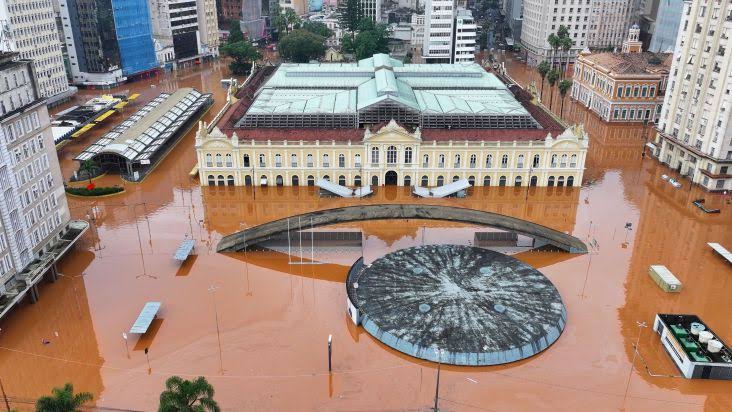Built in the 1960s, Porto Alegre’s massive flood protection system would have easily prevented the city from flooding, if it hadn’t been systematically neglected for 20 years.
By Jeferson Miola
Due to its landscape, Porto Alegre is exposed to flood risks from the Guaíba River.
Therefore, by the end of the 1960s, following the largest disaster to date —in May, 1941— the city was equipped with an efficient flood protection system.
The system consists of a resilient physical barrier that is 2.6 km long, 3 meters high, with a structure that goes 3 meters below ground level, called the Mauá Wall, which has 14 gates to prevent water entry. There are also 68 km of containment dikes and 23 pumping stations to drain water from the city’s lowest areas. It was a true fortress, designed to harmonize human occupation of this territory safely and to protect Porto Alegre from water levels rising up to 6 meters.
This year’s flooding has resulted from a severe climatic event, cannot be fully blamed on the current leaders of Porto Alegre, as it is a consequence of the World climatic collapse generated by necrocapitalist devastation.
However, the severity, human loss, material damage and magnitude of the destruction of these floods are indeed the direct responsibility of the Rio Grande do Sul State government and, in the case of Porto Alegre, its City Government.
On May 5th, the Guaíba River reached a record level of 5.33 meters, the highest in history. Parenthetically, the causes for this, beyond the volume of torrential rains during the period, are associated with agricultural exploitation, especially focused on commodity production, which throughout history has severely damaged nature and altered the conditions of the Guaíba’s tributaries, among numerous other human, social, sanitary, and environmental damages.
Even so, with the Guaíba reaching its highest level ever, the city should have still been well protected by the flood protection system, which was built to withstand water levels up to 6 meters high.
The magnitude of the devastation was not only a consequence of the severity of this unprecedented climatic phenomenon but also of the failure of the City Hall in managing the system implemented over 50 years ago.
The city’s lack of protection is the work of the power consortium that has taken turns leading City Hall for 20 years, transforming Porto Alegre into a laboratory for ultra-liberal experiments. The city’s territory has been turned into a free-for-all for unscrupulous, segregating, and ecocidal economic exploitation by real estate capital in partnership with finance and the hegemonic media.
Neglect of the city’s protection system has been a permanent policy of these successive city governments. In 2018 for example, mayor Nelson Marchezan, abolished the Storm-water Department, leaving the city without an adequate drainage system.
The fact that storm-water pumping station number 17 [EBAP-17] was broken, which caused flooding in an area of the city last September, had been known since 2018, according to a Matinal News report. Despite this, the bolsonarista city government of Sebastião Melo did nothing to solve the problem, even though it had funds available to fix it, and this exacerbated the current catastrophe.
Of the 23 pumps that make up Porto Alegre’s flood protection system, only six are functional, because the other 17 either lack electricity and do not have back up generators or contingency lines, or are submerged—which is tragically ironic.
Basic administrative failures were committed. For example, sealing rubber and pressure screws were missing on the city’s 14 flood gates.
With the aim of preparing the Municipal Department of Water and Sewage [DMAE] for handover to the private sector, the right-wing administrations that have succeeded each other for 20 years in City Hall have continuously dismantled the city’s technical intelligence, so that today the DMAE has only one-third of the operational capacity it had until 2004.
The responsibility of the current City Government is further aggravated by other examples of neglect. One of them has been total inaction in the face of the decay of the city’s flood gates and pumps, even after this was exposed during the storms of September 2023.
During last year’s storm, both the mayor of Porto Alegre mayor and the Rio Grande do Sul governor were warned by scientists, meteorologists, research institutes, and universities about the danger of a new severe weather phenomenon during this season, and it happened.
Despite this, they did nothing to correct the known shortcomings and prepare a contingency plan. Worse, in 2023, City Hall didn’t allocate a single cent for investments in flood protection, and the governor allocated a ridiculous R$ 50,000 for civil defense.
The negligence, omissions, and misguided choices of City Hall are unacceptable given the characteristics of Porto Alegre’s landscape and topography. The warning level of the Guaíba River is 2.5 meters, and the flood level is 3 meters.
In 2015 and 2016, the level of the Guaíba reached 2.94m and 2.65m respectively – warning level. And in September and November 2023, it reached 3.18m and 3.46m, according to City Hall’s own measurements. Despite these eloquent signs, the city government remained irresponsibly inert and continued to neglect its flood protection system.
The people of Rio Grande do Sul and Porto Alegre not only did not deserve this – they didn’t have to go through it. The losses, destruction, and suffering were not caused by nature or some divine punishment but are the direct responsibility of Mayor Sebastião Melo and Governor Eduardo Leite. They need to be held administratively, civilly, and criminally accountable.
Jefferson Miola is a journalist, member of the Institute of Debates, Studies and Alternatives of Porto Alegre (Idea), and former executive coordinator of the 5th World Social Forum.
This article was originally published in Portuguese at Brasil 247 and was translated, with authorization, by Brian Mier. It can be read in its original form here.
